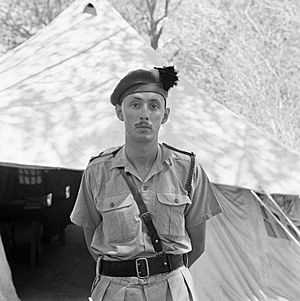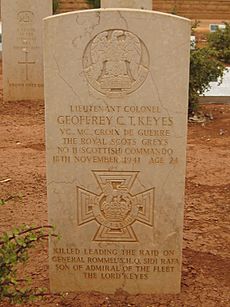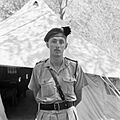Geoffrey Keyes (VC) facts for kids
Quick facts for kids
Geoffrey Keyes
|
|
|---|---|

Geoffrey Keyes
|
|
| Born | 18 May 1917 Aberdour, Fife, Scotland |
| Died | 18 November 1941 (aged 24) Beda Littoria, Libya |
| Buried |
Benghazi War Cemetery, Libya
|
| Allegiance | United Kingdom |
| Service/ |
British Army |
| Years of service | 1937–1941 |
| Rank | Lieutenant Colonel |
| Service number | 71081 |
| Unit | Royal Scots Greys No. 11 (Scottish) Commando Middle East Commando |
| Battles/wars | Second World War |
| Awards | Victoria Cross Military Cross Croix de Guerre (France) |
| Relations | Admiral of the Fleet Roger Keyes, 1st Baron Keyes (father) |
Geoffrey Charles Tasker Keyes was a brave British Army officer during the Second World War. He was born on May 18, 1917, and sadly died on November 18, 1941. He received the Victoria Cross (VC), which is the highest award for bravery in the British and Commonwealth forces. This award is given for amazing courage when facing the enemy. At the time, he was one of the youngest officers to hold the rank of acting lieutenant colonel in the British Army.
Contents
A Young Hero's Start
Geoffrey Keyes was the oldest son of Admiral of the Fleet Roger Keyes, 1st Baron Keyes. His father was a famous British naval hero from the First World War. He also helped create the "Combined Operations" during the Second World War. Geoffrey went to famous schools like Eton and the Royal Military College, Sandhurst, which train future army leaders.
Keyes in the Second World War
Early Battles and Awards
Geoffrey Keyes joined the Royal Scots Greys, a well-known army unit. He fought in battles like the one at Narvik in Norway. Later, he joined No. 11 (Scottish) Commando, a special forces unit. This unit was sent to the Middle East.
In June 1941, during the allied invasion of Syria, his commando unit helped cross the Litani River in Lebanon. They fought against French forces there. Geoffrey Keyes showed great leadership during this fight. For his bravery, he was given the Military Cross. After this, his commanding officer was killed. Geoffrey then took charge of the unit. He was allowed to keep 110 volunteers to form a new commando group.
Operation Flipper: A Daring Mission
In late 1941, a secret plan called Operation Flipper was made. The goal was to attack important enemy bases and communication centers. One part of the plan was to try and capture or stop Erwin Rommel. Rommel was a famous German general in North Africa. This mission was meant to confuse the enemy before a bigger attack called Operation Crusader.
Lieutenant Colonel Keyes led Operation Flipper. He chose the most dangerous part of the mission for himself. This was to attack a house believed to be Rommel's headquarters. The mission started with problems. The submarine landing was difficult, and many men and much equipment were lost. The remaining team then had a tough journey in heavy rain.
Keyes tried to enter the house. He faced a guard at the door. During a struggle, the guard was shot by another commando. Keyes, his second-in-command, and a sergeant went inside. Keyes was shot during the confused fight inside the house. His men carried him outside, but had to leave him behind. The official story says Keyes opened a door, saw Germans, closed it, then reopened it to throw a grenade, and was shot. However, some believe he was accidentally shot by one of his own men.
The remaining commandos were later captured. Rommel ordered that Keyes be buried with full military honours. It was later found out that the house was not Rommel's headquarters. It was a supply center, and Rommel was not even there at the time.
Some historians have studied the mission. They say that the official story of Keyes' bravery award might not be fully accurate. They suggest that the mission might have been driven by Keyes' wish to be as famous as his father. However, they also praise the courage of the ordinary soldiers who carried out the mission.
Remembering Geoffrey Keyes
Geoffrey Keyes' body was later moved. He is now buried at the Benghazi War Cemetery in Libya. He is also remembered on war memorials. One is at King's Mead School in Seaford, Sussex. Another is in the church in Tingewick, Buckinghamshire, where his family lived. His Victoria Cross medal is on display. You can see it at the Lord Ashcroft Gallery in the Imperial War Museum in London.
Images for kids




